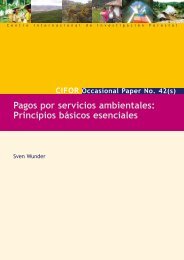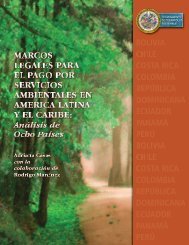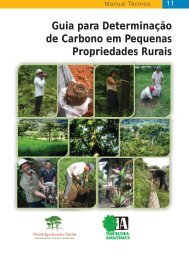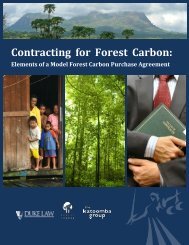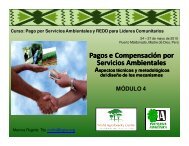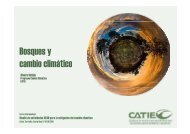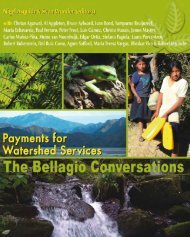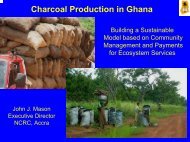Guide on Climate Change and Indigenous Peoples
Guide on Climate Change and Indigenous Peoples
Guide on Climate Change and Indigenous Peoples
- No tags were found...
Create successful ePaper yourself
Turn your PDF publications into a flip-book with our unique Google optimized e-Paper software.
10On the other h<strong>and</strong>, what are theopportunities of REDD/REDD+ for<strong>Indigenous</strong> <strong>Peoples</strong>?If REDD is designed <strong>and</strong> implemented with indigenous peoples <strong>and</strong> theirrights are recognized <strong>and</strong> respected in REDD policies <strong>and</strong> programmes,this can result in even greater c<strong>on</strong>tributi<strong>on</strong>s of indigenous peoples toemissi<strong>on</strong>s reducti<strong>on</strong> <strong>and</strong> carb<strong>on</strong> sequestrati<strong>on</strong>. If REDD+ can, indeed,stop deforestati<strong>on</strong>, this is already a big step in saving indigenous peoples'territories <strong>and</strong> diverse forest cultures. However, this is easier said than d<strong>on</strong>e.Deforestati<strong>on</strong> may be stopped but indigenous peoples may be kept awayfrom these. The fight for indigenous peoples' rights is always an uphill battlebecause <strong>on</strong>e of the basic rights is the collective right to l<strong>and</strong>s, territories<strong>and</strong> resources. Due to the difficult nature of this struggle, it is important touse every opportunity available to pursue this fight. And the emergence ofREDD+ is <strong>on</strong>e of these.• Increased visibility of indigenous peoples' rights <strong>and</strong> c<strong>on</strong>cerns <strong>and</strong>inclusi<strong>on</strong> of these in the negotiating text. Am<strong>on</strong>g the secti<strong>on</strong>s of thenegotiating documents, it is the REDD+ text which c<strong>on</strong>tains the biggestnumber of references to indigenous peoples <strong>and</strong> local communities;indigenous peoples' rights; the UNDRIP; FPIC; <strong>and</strong> traditi<strong>on</strong>al knowledge<strong>and</strong> traditi<strong>on</strong>al livelihoods. In the past, except for some of the IPCCReports, the phrase “indigenous peoples <strong>and</strong> local communities” cannotbe found in any final documents of the UNFCCC.• Greater challenge for unitybuilding<strong>and</strong> more effectivelobbying <strong>and</strong> advocacy work.<strong>Indigenous</strong> peoples should,therefore, strengthen unity<strong>and</strong> sharpen their advocacy<strong>and</strong> lobbying skills to ensurethat in Copenhagen, some - ifnot all - of these referencesare maintained. This will beREDD+ text in the negotiatingdocuments c<strong>on</strong>tains the biggestnumber of references to indigenouspeoples <strong>and</strong> local communities;indigenous peoples' rights; theUNDRIP; FPIC; <strong>and</strong> traditi<strong>on</strong>alknowledge <strong>and</strong> traditi<strong>on</strong>al livelihoods.a big gain for indigenous peoples who have been trying their bestto get something into the UNFCCC COP decisi<strong>on</strong>s for years but neversucceeded.• Chance to pursue rights claims to forests <strong>and</strong> forest resources,including carb<strong>on</strong>, <strong>and</strong> needed policy <strong>and</strong> legal reforms. Use renewedfocus <strong>on</strong> forests to push for legal reforms of forest laws <strong>and</strong> otherlaws dealing with the ownership, access <strong>and</strong> c<strong>on</strong>trol of forests at thenati<strong>on</strong>al <strong>and</strong> local level. This is a key step in achieving REDD+. The goal78 <str<strong>on</strong>g>Guide</str<strong>on</strong>g> <strong>on</strong> <strong>Climate</strong> <strong>Change</strong> <strong>and</strong> <strong>Indigenous</strong> <strong>Peoples</strong>



